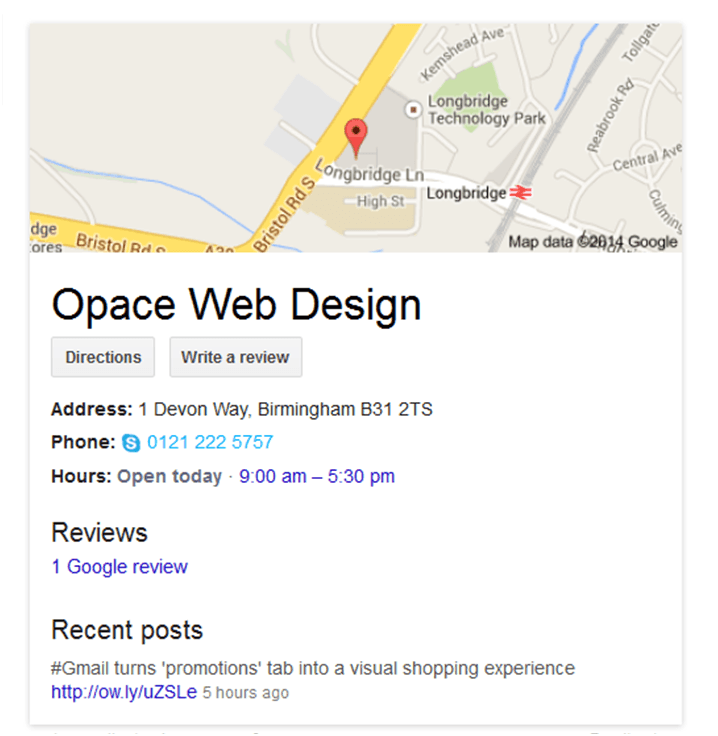So, what are rich snippets?
- 1 So, what are rich snippets?
- 2 Rich snippets infographic guide
- 3 Types of rich snippets and structured data
- 4 Including Google Authorship and Publisher mark-up
- 5 Benefits of making your website rich snippets friendly
- 6 How to implement rich snippets
- 7 Getting to grips with micro data
- 8 Tools to help you along the way
- 9 Plugins and extensions for Joomla, Magento and WordPress
- 10 Can you get penalised for using rich snippets?
- 11 Conclusion
- 12 Follow us and share if you found this blog useful…
Have you ever noticed that some listings in Google search results look so much better than others? You know, those ones that are equipped with little extras like images, prices and ratings? Well they have been created using rich snippets (also referred to structured data) and can significantly improve your website’s SEO and click-throughs.
Google introduced rich snippets back in 2009 to help improve its search engine results for users. They also gave webmasters the opportunity to advertise their content better, allowing them to provide additional information about themselves and their site in order to persuade users to click through to their website. See below for an example of a rich snippet.
We’re in no way comparing these solutions as we haven’t used them ourselves but which one would you rather click?
Example without rich snippets:

Example with rich snippets:

Notice the difference? The second example comes with a video, starred ratings, reviews, price and stock. Rich snippets allow Google to add these extra bits of information (and much more) about your website to its search listings.
Ratings in particular can be very powerful when it comes to instilling confidence in your brand attracting clicks.
Rich snippets infographic guide

Types of rich snippets and structured data
Rich snippets are all about providing Google with a little extra information about your website so it can display more useful information to those performing relevant searches. Rather than simply matching search results using keywords, Google instead uses your rich snippet mark-up to provide users with more accurate and relevant results.
This extra mark-up information will appear alongside your page title, URL and meta description and can be any of the following things:
- Events (Displays name of event and location)
- Local businesses (Provides contact information to help users find local businesses’ locations)
- Music (Previews song list so users can directly click onto the song they want to listen to)
- Navigation breadcrumb trails
- Offers
- Organisations (Helps Google identify businesses as local. Includes reviews and contact information)
- People (Displays author bio, links to content they have created)
- Products (Used for e-commerce sites to display prices, reviews and availability)
- Recipes (Displays image of food and recipe rating)
- Restaurants (Shows location, rating, link to menu)
- Reviews (Applies to single product / service pages)
- Software (Displays reviews)
- Videos (Shows clip and reviews)
For more info please see: https://support.google.com/webmasters
It is a known fact that rich snippets can help brands to generate more traffic from search engine results pages. In order to make this appear for your site in search results, you will need to do a little coding! Luckily for you, we are here to explain how to implement rich snippets as well as how it will benefit your brand.
A great way of highlighting your company in search results is to include Google Authorship and Publisher mark-up.
This feature allows users to see the author’s name, their Google Plus profile picture, their number of followers, company information, reviews and links to Google Plus content they have created.
In order to set this up, you will need to insert either ‘Rel=Author’ or ‘Rel=Publisher’ (depending on which you are) into the HEAD section of your site. This will need to link back to your Google Plus profile.
We’re using examples from our own website here, but this is what you can expect to see with Author mark-up:

Publisher (company) mark-up
And this is what you can expect to see with Publisher mark-up, shown in the right-hand column of Google’s search results:

You need to have a Google Plus personal profile and business page for this to work, as this is what Google uses to identify you. It is also important that your Google Plus profile is linked to the sites where you are an author or publisher. When you edit your Google Plus profile, you will find a section at the bottom called links. This is where you can insert the hyperlinks to the websites where you publish content. For your personal profile you will also need to set the “Contributor To” with your web address under links – this tells Google that you are an author.
Every time you publish a new page or blog post on your website and it is ranked by Google, it will show up on search engine results pages with your Google Plus image next to it as well as a link to your Google Plus profile. Users are much more likely to click on a link with an image, as they look more important and of high authority.
Use Google Authorship mark-up to enhance search results for your website content and blogs.
For more information how to impliment this, here are two great resources:
Benefits of making your website rich snippets friendly
Aside from your search engine results for your website looking a little more aesthetically pleasing, there are many other benefits of making your website rich snippets friendly, which we have outlined below.
Eye catching search results
Not everyone uses rich snippets, so if you do, it is likely that the search result for your website will stand out amongst the rest. Including microdata like a bio image, video clip or rating is basically like jumping up and waving in users’ faces saying ‘click on me I’m the best result.’ It will draw search engine users’ attention away from competitors’ links, to your own website, perhaps even if they are ranking higher than you.
Increased click-through rate
By making your website rich snippets friendly, you can encourage more people to click through to your site when it shows up on search results pages. The more people that click through to your site, the better chance you stand at increasing your conversion rates. Including rich snippets data should also help to lower your bounce rate. This is due to the fact that users will be making a more informed decision when clicking on your link and are therefore more likely to be satisfied with the content they find once they click through to your website.
SEO benefits of rich snippets
Rich snippets can also benefit your SEO in terms of the user’s search experience and helping them to find the most relevant result before they even click it. Tagging your pages with ‘rel=author’ can help to build up your brand’s reputation and credibility.
How to implement rich snippets
In order to implement rich snippets, you will need basic HTML knowledge.
The first step will be to choose a mark-up format. Google personally recommends that you choose micro data. You will then need to choose your mark-up content. This is what will show alongside your page title and URL in search results. Google accepts various different types of mark-up content including Google rich snippets reviews, people, products, businesses and organisations and even events. Once you have chosen your mark-up, you will need to test it.
For more information we highly recommend reading this Google Rich Snippets tutorial.
Getting to grips with micro data
In 2011 Google agreed to work alongside other search engines like Bing and Yahoo to support a set of schemas that could be used across search engines to help improve search results. A site called ‘schema.org’ was created to provide webmasters with a list of shared vocabularies they could use to mark up their pages for rich snippets. The terms used by schema.org are all based on micro data. The method for implementation is fairly straight forward – schema vocabulary + microdata added to HTML content of website = a mark-up for rich snippets.
Tools to help you along the way
Implementing rich snippets can be a little tricky, especially if you lack HTML knowledge.
Schema Creator
An excellent tool you can use to help you create schemas can be found here: http://schema-creator.org. Using this tool you can create microdata for your site within minutes.
Data Highlighter
At the end of 2012, Google announced that a new featured would be added to its Webmaster Tools called the Data Highlighter. This tool helps novice users (who may not have a lot of coding knowledge) to add rich snippet mark-up content to their website. The tool can be accessed from the optimization tab in your Google Webmaster Tools. All you have to do is select the content from your web page, select the type of data it represents and then publish it as a rich snippet.
Structure Data Markup Helper
Another tool that is very useful is the Structure Data Markup Helper, which is like a Google rich snippets generator and is very simple to use, providing a click and generate user interface.
Google Structured Data Testing tool
Whatever tool you decided to use to create your microdata, once you have added it to the relevant page we recommend testing it with Google’s rich snippet testing tool, to check that Google can read it and that it doesn’t contain any errors.
Plugins and extensions for Joomla, Magento and WordPress
To make it a little easier for you to manage your rich snippets, various different web developers have created plugins and extensions for the popular content management systems Joomla, Magento and WordPress.
We have listed some of the very best plugins and extensions for the popular content management systems below.
WordPress Rich Snippets
A rich snippets WordPress plugin that is very popular is ‘All In One Schema’.
This adds a rich snippet meta box to your page editors so you can easily add rich information to feature on search results showing your posts and pages. Creating a snippet is as simple as filling in a few details. All In One Schema is one of the more comprehensive rich snippets plugins for WordPress. It covers all types of rich formats including item reviews, events, people, products, recipes, software applications and videos.
Rich Contact Widget is another WordPress plugin that is useful for adding rich contact information to the search results for your website. The plugin adds a simple rich contact widget to your website. It is particularly beneficial for small, local businesses who may want to add their contact information in a microdata format.
Whereas some WordPress plugins are for all sites, others have been created for certain types of site. For example WP Customer Reviews is a WordPress rich snippets plugin that allows users to submit reviews, which would be beneficial for businesses offering products or services.
Joomla & K2 Rich Snippets
One of the best rich snippets for Joomla sites is J4Schma. This plugin is a visual editor that allows you to create rich snippet data using schema.org (the site we mentioned earlier) attributes. Using this plugin, you will be able to quickly add them to your pages. Rich Snippets Vote is another good extension which adds structured data support for the Joomla Voting System and K2 extension.
Magento Rich Snippets
There also a number of great rich snippets Magento modules that help you highlight your products in search results and boost organic traffic to your site. One of these is the Rich Snippets Suite. This paid-for plugin helps you to create structured data for your search listings on Google, Yahoo and Bing using schema.org mark-up. If you are looking for a free rich snippets plugin for Magento, we highly recommend checking out MSemantic: Semantic SEO for Rich Snippets in Google and Yahoo. This module adds rich data-markup to your ecommerce store pages so that search engines can display richer item previews in their search results. The microdata includes information about prices, availability, delivery options and images.
It is important to make sure that you stick to Google’s Rich Snippets Quality guidelines or you may end up getting penalised.
Can you get penalised for using rich snippets?
If you do not use your mark-ups correctly then you may receive a manual action penalty from Google.
Unethical Google rich snippet examples include marking up content that cannot be seen by users, marking up misleading or irrelevant content and carrying out any other marking up procedures that go against Google’s Rich Snippet Quality guidelines. If you are penalised by Google for misusing rich snippets, it is likely that you will receive a message outlining the following:
‘Markup on some pages on this site appears to use techniques such as marking up content that is invisible to users, marking up irrelevant or misleading content, and/or other manipulative behavior that violates Google’s Rich Snippet Quality guidelines.’
It has even been suggested that rich snippets may be changed so that only reputable sites can display them. In order to continue reaping the benefits of rich snippets, make sure you are following Google’s Rich Snippet Quality guidelines.
Conclusion
Using rich snippets will not only make your listings more attractive in search results, but it will also improve your sites SEO and help drive more relevant traffic through to your page. By increasing your websites click-through rate, you should in turn see an increase in conversion rates. The more users you convert, the more profit you will make. To make creating rich snippets for your website easier and quicker, we highly recommend using one of the plugins or tools featured in this article. There are plenty available online – just search and see! If you are still unsure how to set it up or find that your rich snippets are not showing in search results, get in touch with a member of our team today.
If you found this blog useful you can follow us below to get the latest as we release more useful internet marketing blogs over the coming months!
And don’t forget to share…

![Seo content creation guide for good content - why good content matters: seo content creation guidelines [updated] Seo content creation guidelines for good content](https://www.opace.co.uk/wp-content/uploads/2024/03/SEO-content-creation-guide-for-good-content-150x150.jpeg)




0 Comments